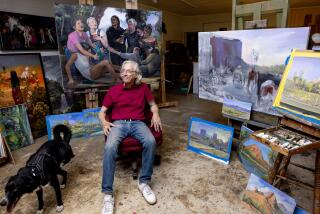WORKS OF AN AMERICAN IN PARIS COME TO SAN DIEGO
- Share via
SAN DIEGO — William Klein practices an aesthetics of immersion, plunging into crowds with his Leica camera, photographing what is there.
“What I like about my kind of photography,” he said, “is the excitement I think gold prospectors must get, the excitement of never knowing when you’re going to hit pay dirt.”
The expatriate American photographer visited San Diego recently in connection with the opening of an exhibition surveying more than 30 years of his work.
“William Klein: An American in Paris,” at the Museum of Photographic Arts in Balboa Park, includes 113 images that show the aggressive, confrontational, participative, provocative and improvisatory qualities for which he is well known. The exhibition includes images of nuns in St. Mark’s Square in Venice, crowds lining the streets for a funeral and a Rolling Stones concert in Paris.
“It’s not necessary to make order out of chaos,” he has said. “Chaos itself is interesting.”
That summarizes the artistic vision that he discovered in his mid-20s and that has guided him since.
Klein, born in New York in 1928, finished high school at 14 and enrolled in the City College of New York. At 18 he joined the Army, which sent him to Europe, where he won his first camera in a poker game.
But his first artistic interest was painting. In 1947, he enrolled at the Sorbonne, where he completed his formal education. Later he studied for a short time with Fernand Leger.
“I went to Paris,” he said, “because I wanted to be an artist, and Paris was the place you grew up dreaming about. And I stayed in Paris because that’s where you could be an artist.”
In 1954, he visited New York, which he loved and hated. Two years later in Europe, he published the tough photographs he had made during his visit. Never released in the United States, “Life Is Good and Good for You in New York: Trance Witness Revels” is now an expensive, rare book.
“I found New York tragic,” he said. “It was like the dream of the whole Western world. But the New York where I grew up was no bargain. It felt like there was no way out. I showed that in the New York book.
“I’d take pictures that were innocuous. It was like holding up a mirror. But publishers, you know, they go from Fifth Avenue to Madison Avenue and they said, ‘This isn’t New York!’ ”
Klein made his reputation in Europe where his influence is more substantial than in the United States. In December he received the Grand Prix National de France, an award sponsored by the government for individual artistic achievement.
He compared his work to that of the popular media.
“I like the brashness of the paparazzi ,” he said. “But they went after celebrities.
“What I wanted was a ‘scoop’ of non-events, as if the ordinary things people were doing were the most important things happening. You hardly know where to look. Everything is intense with meaning.”
Klein is no photographic ideologue.
“I don’t believe in a ‘decisive moment,’ ” he said candidly. “My idea of photography was something you could use. So you could do anything with it you wanted.
“I use the street as my studio and whatever technique I need. The way I take a photograph depends on the subject matter.”
Klein pioneered such innovations as the “flash with blur” and the use of telephoto and wide-angle lenses in the streets.
“I’ve kept a lot of photographs other people would have thrown away. And I’ve learned how to use them. They’re like ready-mades,” he said.
The exhibition, organized by museum executive director Arthur Ollman, continues through April 5. It will not travel elsewhere.
More to Read
The biggest entertainment stories
Get our big stories about Hollywood, film, television, music, arts, culture and more right in your inbox as soon as they publish.
You may occasionally receive promotional content from the Los Angeles Times.










